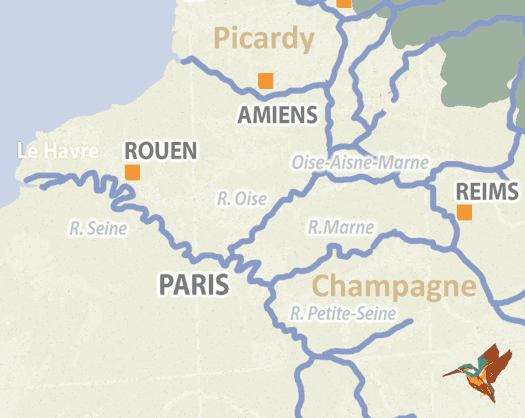Rivers and Canals of Normandy, Paris, Oise and Aisne
 Le Havre and Honfleur are both possible entry ports for boats planning to connect with the River Seine after crossing the English Channel. Paris is one of Europe’s premier waterways destinations, arriving there by river is an unforgettable experience and the Arsenal marina at the junction of the Seine with the Canal St Martin is the perfect place to stay, as it is in the heart of the fashionable Marais quartier.
Le Havre and Honfleur are both possible entry ports for boats planning to connect with the River Seine after crossing the English Channel. Paris is one of Europe’s premier waterways destinations, arriving there by river is an unforgettable experience and the Arsenal marina at the junction of the Seine with the Canal St Martin is the perfect place to stay, as it is in the heart of the fashionable Marais quartier.
The Seine is a well-connected waterway: it joins the Oise at Conflans-Saint-Honorine, leading north east to the Escaut and Rhine basin. The Oise in turn connects to the River Aisne which has junctions with the four key canals that serve north east France. Locally, a number of interesting canals criss-cross Paris: trip boats ply the atmospheric canal St Martin if you don’t want the hassle of exploring it in your own boat and there are also the canalised River Ourcq, the Canal de l’Ourcq, the Canal Saint-Denis and the Clignon branch.
▶ Detailed canal and river information – North-Central region
Lower Seine or Seine Aval
The Seine rises on the sun-kissed escarpment of the Cote d’Or and travels for almost 800 km to the English Channel near Le Havre. For centuries it used to be unnavigable on account of its limited depth, a problem which was solved when it was canalised in the 1840s and five locks and weirs were built, raising the depth to 1.6m. Additional development in 1860 and 1880 added three more locks and increased the draught to 3.2m and in the mid-20th century new lock chambers gave a sill depth of five metres as far as Paris.
Today the river is a major commercial artery used by freighters, push-tows, and a growing fleet of luxury cruise ships. From the coast as far as the sea port at Rouen, cruisers will find themselves jockeying for position with vessels of up to 120,000 tonnes but sharing space on this magnificent river is worth it, if Paris is your destination.
▶ Detailed canal and river information – Lower Seine
Canals of Paris
If you think of Paris, you immediately think of the Seine, but France’s capital boasts 120km of canals, some of them photogenic backwaters which are among the city’s best kept secrets. Traffic on these canals largely consists of leisure craft and passenger boats since Paris opened up the entire network in the 1980s following the decline of commercial traffic. A small annual licence fee is charged to access the Canal Saint-Denis and the Canal Saint-Martin and it also covers the Canal de l’Ourcq. Over time the network’s narrow locks have been replaced in order to ease the passage of recreational navigation and now only the one at Varreddes requires upgrading.
The L’Ourcq was first surveyed by Leonardo Da Vinci and initial work on canalisation began in the 16th century when it led to the River Marne by means of primitive locks. Further improvements were made in the middle of the 18th century but it was Napoleon who kick started the canal as we know it today and work was completed in 1822. Its main function now is to feed the other two Paris canals and provide water for cleaning the streets. The Canal Saint-Martin was designed to bypass Paris in the days before the Seine was canalised and used to dry out in the summer; Napoleon also endorsed this project which was finished in 1825 after he had died. The Canal Saint-Denis provided the other half of the short cut and the two were linked by the Canal de l’Ourcq.
▶ Detailed canal and river information – Canals of Paris
River Oise and Canal Lateral à la l’Oise
Between them, the River Oise and its canal form the main arterial waterway from the Seine to Northern France, covering a total distance of 138k from Conflans-Sainte-Honorine to the Saint-Quentin canal. Canalisation of the river was done in 1835 and larger locks were added in 1910 and again in 1965. Further upgrades are being carried out now, including extensive dredging and widening, in preparation for the construction of the Seine Nord Europe Canal, an immense project that is intended to link the basins of the Rivers Seine and Rhine. From the junction with the Canal de Nord the lower section of the Canal Lateral is to be further improved or rebuilt to provide a parallel path to the Seine Nord Europe Canal.
This waterway is mainly used by commercial barges carrying freight, but cruisers might find it a useful link to some of the less industrialised canals and rivers in the north of France.
▶ Detailed canal and river information – River Oise and Oise Canal
Canal de l’Oise à l’Aisne
The canal is on one of the main routes used by boaters heading south from the entry ports of Calais and Dunkerque or from Belgium and was opened in 1890 as part of the Freycinet plan, providing a useful short cut between Champagne and the Canal Saint-Quentin. It is a junction canal and its 48km length connects the Oise and Aisne and there are short aqueducts at either end carrying the waterway over the rivers – the one across the Oise is particularly fine.
The summit between the two valleys features a 2.3km tunnel operated by a traffic light system at Braye-en-Laonnais and it is worth remembering that commercial traffic takes priority both at the tunnel and the locks. The canal still carries freight barges and often as many as twenty pass through on a typical day. In spite of this, the route is extremely attractive, passing through remote and rural countryside, and makes for a pleasant cruise.
▶ Detailed canal and river information -Canal de l’Oise à l’Aisne
Canal de l’Aisne à la Marne
Forward-thinking engineer Hugues Cosnier, who built the Canal de Briare, had a vision for an orbital network of canals passing Paris to the east. He built the section from Reims to Sillery in the seventeenth century and the remaining part was opened in 1841, but his dream of linking the Loire to northern France was never realised and the Canal de l’Aisne a la Marne represents a significant part of his legacy. Running for 58km from Berry-au-Bac to Conde-sur-Marne, the highlight of the route is the cathedral city of Reims. For more than a thousand years, French Kings were traditionally crowned here and today it is the unofficial capital of the champagne region. A number of the great champagne houses have their headquarters in the city and you can while away several happy hours doing tastings or even guided tours at various illustrious establishments.
The canal is generally used by leisure traffic in transit from the north to the south, but there remains a sizeable number of commercial vessels carrying grain from the surrounding countryside into Reims, where it is transferred to road for onward transport.
▶ Detailed canal and river information – Canal de l’Aisne à la Marne
French waterway regions – North | North-East | North-Central | West | Centre | South-East | South | South-West
British-Irish waterway regions – Northern | East Midlands | West Midlands | Welsh | Southern | Scottish | Irish
